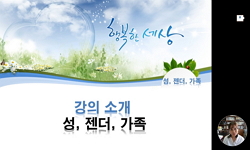This study is focused on the factors of gender stereotype and discrimination in Sejong-Korean with the presumption – Korean text book serves as a vehicle to get across grammatical, social and cultural value. Also, it holds the prime purpose to ...
http://chineseinput.net/에서 pinyin(병음)방식으로 중국어를 변환할 수 있습니다.
변환된 중국어를 복사하여 사용하시면 됩니다.
- 中文 을 입력하시려면 zhongwen을 입력하시고 space를누르시면됩니다.
- 北京 을 입력하시려면 beijing을 입력하시고 space를 누르시면 됩니다.
https://www.riss.kr/link?id=T14888963
- 저자
-
발행사항
서울 : 韓國外國語大學校 敎育大學院, 2018
-
학위논문사항
학위논문(석사) -- 韓國外國語大學校 敎育大學院 , 한국어교육전공 , 2018. 8
-
발행연도
2018
-
작성언어
한국어
- 주제어
-
DDC
495.107 판사항(22)
-
발행국(도시)
서울
-
기타서명
A Study on the Education of Gender Recognition for the Korean Language Education : Focusing on Sejong Korean 1.2.3
-
형태사항
81 p. : 삽도 ; 26 cm.
-
일반주기명
한국외국어대학교 논문은 저작권에 의해 보호받습니다.
지도교수: 정해권
참고문헌 : p. 76-79 - 소장기관
-
0
상세조회 -
0
다운로드
부가정보
다국어 초록 (Multilingual Abstract)
This study is focused on the factors of gender stereotype and discrimination in Sejong-Korean with the presumption – Korean text book serves as a vehicle to get across grammatical, social and cultural value. Also, it holds the prime purpose to find the wrongs from the contemporary text books to allow foreign users to evaluate and criticize biased gender stereotype, while establishing the foundation for a bettered education in terms of gender equality.
The method to analyze and its criteria were taken from the literature review. In addition, the theories were taken in order to analyze gender stereotype, along with the analysis of critical discourse theories in order to highlight the social cultural approach in the facet of language education.
The target of analysis was Sejong- Korean published based on the international standard criterion. The visual and the language aspects were separated beforehand to tabulate the gender stereotype and discriminative expressions included in them. Also, to deduce the degree of the bias and the opinions, the actual users with varying nationalities and genders were interviewed, resulting in the analysis of gender recognition.
As a result, for the visual data, the discriminating factors were found in the fields of career, personality, and appearance. The data showed patriarchal aspect as male characters appeared much more often as highly professional and dominant in the economic activities compared to female characters. Besides the economic expressions, the daily life activities of two genders also showed contrast. The activities of the female characters, such as reading and chatting, appeared mostly static, while male characters were illustrated as dynamic with activities such as ball games, fishing, and hiking. Even the males’ deliberate preferences on the action film in the text book showed the bias.
In the language aspect, the text showed that the male characters were mostly taking the initiatives in terms of starting the conversation and decision-making. Also the text portrayed biased stereotype of female characters with avoiding holding heavy objects or having difficulties in using the computer.
Understanding the huge influence a text book could hold, the gender bias and discrimination in the context should always be aware of. As to resolve, this study suggests the redirection of discriminating expressions as well as the Korean-learning-method via the use of Critical Discourse Analysis.
Because Confucianism has been deep rooted in Korean society throughout its long history, the gender role is highly distinctive. To have the students view the gender inequality with critical eye, the gender role in education is an ideology being emphasized globally. Appropriate education to imbue the correct gender role should be well-established.
It is expected that this very study would lead to the correction of the above discussed facets in Korean text books, while applying various values such as religion, race, and age to the Korean education to improve as well.
목차 (Table of Contents)
- 1. 서론 1
- 1.1. 연구 목적 1
- 1.2. 선행 연구 3
- 1.2.1. 젠더와 언어 3
- 1.2.2. 교재 분석 연구 4
- 1. 서론 1
- 1.1. 연구 목적 1
- 1.2. 선행 연구 3
- 1.2.1. 젠더와 언어 3
- 1.2.2. 교재 분석 연구 4
- 1.3. 연구 방법 6
- 2. 이론적 배경 8
- 2.1. 외국어 교육에서의 젠더에 관한 논의 9
- 2.1.1. 성 고정 관념과 젠더 차별 9
- 2.1.2. 젠더와 평등 13
- 2.2. 비판적 언어 인식 16
- 3. 세종한국어 교재에 나타난 젠더 표현 분석 23
- 3.1. 시각 자료에서의 젠더 불평등 28
- 3.2. 언어 자료에서의 젠더 불평등 32
- 3.2.1. 담화 구조에서의 젠더 불평등 34
- 3.2.2. 담화 내용에서의 젠더 불평등 36
- 3.2.3. 어휘 사용에서의 젠더 불평등 47
- 3.3. 세종한국어 교재 학습자 젠더 수용 인식 분석 49
- 3.3.1. 인터뷰 설계 49
- 3.3.2. 인터뷰 결과 분석 51
- 4. 젠더 평등 표현을 활용한 한국어 교육 방안 59
- 4.1. 세종한국어의 젠더 차별 표현 수정 방안 60
- 4.1.1. 시각 자료의 수정 방안 60
- 4.1.2. 언어 자료의 수정 방안 67
- 4.2. 젠더 평등 한국어 교육을 위한 교안 69
- 5. 결론 73
- 참고문헌 76
- Abstract 80












